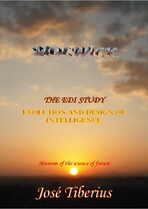8. Family and identical twin study
The Global Model has consolidated and improved the good results of the Social Model in terms of the transmission of intelligence from one generation to another, the LoVeInf method in such transmission, and concentration of intelligence genes in a chromosome.
It also succeeded in confirming the ability of the general theory of Conditional Evolution of Life (CEL) to generate sets of vectors of intelligence quotients W° that behave like the observed ones, which again settles that the related genes are on the sex-linked chromosome.
This section includes, on the one hand, the correlation and multiple regression graphs of the Global Model on the adjustment of the evolution in the intelligence coefficients of the mothers and the hypothesis of sexual selection; both already explained and used previously for the representation of the Globus Model and Sexy Globus Model respectively.
On the other hand, it shows some curios of cases for a better understanding of both biological and statistical models of sex-linked genes and chromosomes within an approach to family and intelligence.
8 - Family - Identical twin study
| Graphics | Family relationships | Observations |
|---|---|---|
| q071° q072° |
Evolution with IQ Mothers | Adjustment for Globus Model |
| q081 | Relation between children H |
Identical twins |
| q082° | Siblings or dizygotic twins | |
| q083° q084° |
Clones Replica q053° Clones Replica q056° | |
| 1 Mothers q085 2 Mothers q086° |
Progenitors | Rearrangement criteria M and evolution |
| 3 Fathers q087 4 Fathers q088° |
Rearrangement criteria F and evolution | |
| q089° | Sexual selection - Couples | Without sexual selection q063° With - Sexy Globus Model |
8.a) Sensitivity analysis of internal evolution parameters
The theoretical model of the CEL shows there is the evolution of intelligence and environmental influences, but the capacity increases throughout life and transmits to the offspring through genes and chromosomes linked to sex.
It also indicates that internal evolution will only occur in male genes because they are continually renewing in nature, while female eggs do not differ from very early stages.
The method compares the Sexy Globus Model results of only female intelligence evolution with the results without any improvement, and with exclusive intelligence male change. The vast correlations and regression graphs the model represents visually are in graphs q173° and q176°, which speak for themselves.
The CEL and the Global Cognitive Theory explains in detail the primary arguments that nullify any sexist interpretation of the results, given the different biological functions of men and women.
8.b) Intelligence in twins, brothers, and clones
The simulation of the behavior of the computer-generated IQ variables allows the design of model configurations without the need for an additional sample. This aspect is essential since the source data of this type of analysis are not only costly but also almost impossible to obtain.
An example of an application is to analyze how relational intelligence can vary in siblings since it is possible to obtain many W° vectors from the same fathers and mothers. Therefore, the model can compare the genetic variability of intelligence with the observed among siblings to verify different hypotheses about the behavior of intelligence genes and chromosomes, and whether they are sex-linked or not.
For example, specific conditions to the simulation of the Mendelian genetic combination will give IQ vectors of twins.
Identical twins.
The similarity of the variables H in the graph q081 could correspond to the IQ of identical twins while the W° would be only normal brothers since it comes from the data of the same fathers and mothers.
This behavior repeats on numerous occasions when the sort order is one of the variables H –children of the families.
Dizygotic brothers or twins
In the graph q082°, the statistical ordering criterion is W°, and the behavior is somewhat different, it seems that the four variables of IQ correspond to identical twins of the same families. However, it is just a case.
Clones
Another example of application may be that different intelligence tests detect different types of human brain functions that make up relational intelligence.
The correlation and multiple regression graphs q083° and q084° clearly show how W° can resemble one or another variable H depending on the randomness involved in the Mendelian genetic combination of chromosomes of both sexes. The comment will be easy to understand when comparing the images q053 and q056, respectively.
All variables H correspond to a mono-environmental monozygotic twin. While W° will be just a brother, sometimes it will look alike and sometimes not so much.
It is not difficult to imagine some new and exciting studies on these peculiar characteristics of the sex-linked genes and chromosomes of intelligence with a family approach coefficient.
8.c) Asymmetric behavior of the mothers M and fathers F vectors
Now, the behavior for R of the same centered variables is more precise when ordering the data in two other forms, that is, M and F, both with and without evolution.
The correlations obtained are quite low because M and F are not very good as management criteria and go down even more when introducing evolution.
The exciting facet is to observe the differences between the two variables of the parents. F is a better sorting criterion than M, and its correlation with R is higher. However, with evolution, the correlation of F with R° lowers, and that of M goes up.
Regardless of the quantity, it looks like the drawn curves are from mirror images.
Other curiosities are the difference in the behavior of W° and its variation to the parents M and F as statistical ordering criteria.
8.d) Intelligence in sexual or couple selection
Due to the relevance of the subject, the confirmed hypothesis about sexual selection and intelligence is also here. Besides, to remark that the concentration of genes related to intelligence in the sex-linked chromosome allows the validation of the hypothesis of sexual selection.
Regarding the possibility of establishing some additional hypotheses to the Global and Globus models to improve their goodness-of-fit, The EDI Study incorporates the relevance of the difference in intelligence between the father and the mother as conditioning for the effective initial acceptance of the couple's configuration.

The additional hypothesis introduced in the model is to establish as the limit in the difference in intelligence that:
“The most potent chromosome of one of the couple's members has to be at least as powerful as the least potent chromosome of the other and vice versa.”
In the generation of the new values, only ten of the seventy IQs of the R° function change by more than two percent of their value. The vector W°° adjusts by the new condition imposed on the couple selection.
The model improves to some extent with the individual variables, but the effect is much more noticeable with the centered variables. The GMCI, with the sorting criteria * M1P1°, goes from 15.61 to 17 and the maximum r² from 0.89 to 0.97 for the objective function R°° (see graph q063°)
For the objective function M & P, the GMCI stands at 17.62 when it was previously at 17.77, and the maximum r² rises from 0.89 to 0.97. As usual, the maximum values of r² correspond to the variable X6 –the average of 6 variables of the children.
The correlation and multiple regression graph of the Sexy Globus Model collecting visually these values is undoubtedly impressive, see graph q077°
